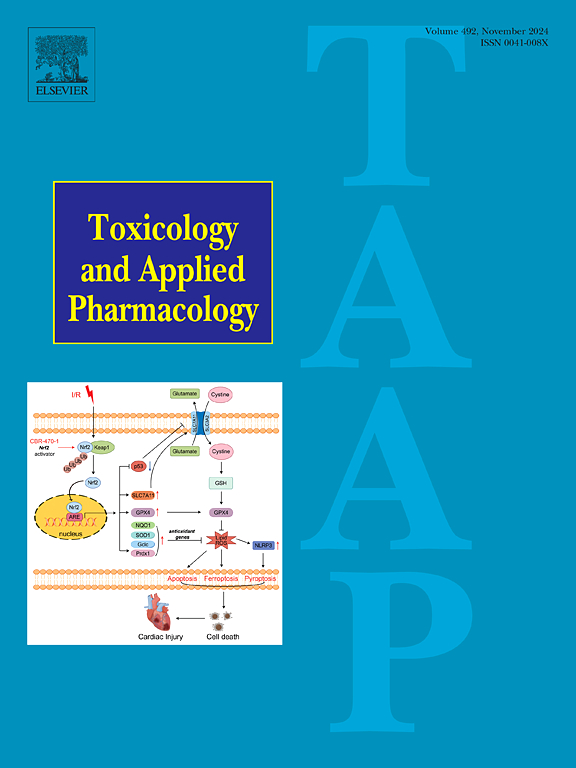The synthetic opioid isotonitazene induces locomotor activity and reward effects through modulation of the central dopaminergic system in mice
IF 3.3
3区 医学
Q2 PHARMACOLOGY & PHARMACY
引用次数: 0
Abstract
Synthetic opioids, which differ from fentanyl, have recently emerged as new psychoactive substances and pose public health concerns. The pharmacological effects and drug dependency of these benzimidazole-based opioids, also known as nitazenes, remain unclear. In this study, we examined the selectivity of opioid receptors, effects on motor activity, and expression of reward effects for isotonitazene, which has been detected in many poisonings and fatalities since 2019. Isotonitazene was most selective for the μ-receptor and exhibited more potent agonist effects, with an EC50 of 0.02 nM, than morphine (EC50 = 34 nM) and fentanyl (EC50 = 4.0 nM). In ICR mice, isotonitazene (up to 0.05 mg/kg) increased the locomotor activity in a dose-dependent manner. This effect was significantly suppressed by pretreatment with the opioid receptor antagonists naloxone (3 mg/kg) and β-FNA (1 mg/kg), the dopamine D1 receptor antagonist SCH23390 (0.5 mg/kg), and dopamine D2 receptor antagonist raclopride (6 mg/kg). The reward effects of isotonitazene, evaluated using conditioned place preference (CPP) in mice, showed that conditioning with isotonitazene produced significant dose-dependent CPP scores. Microdialysis analysis also confirmed that the isotonitazene dose that induced CPP (0.05 mg/kg) significantly increased dopamine levels in the nucleus accumbens of mice. These results suggest that isotonitazene, similar to fentanyl and morphine, is a compound with a high risk of forming drug dependence and reward effects via the dopaminergic nervous system. This study provides foundational data for biological evaluation of other nitazene compounds.
合成阿片样物质异戊二烯通过调节中枢多巴胺能系统诱导小鼠运动活动和奖励效应
与芬太尼不同的合成类阿片最近成为新的精神活性物质,并引起公共卫生关切。这些以苯并咪唑为基础的阿片类药物,也被称为nitazene,其药理作用和药物依赖性尚不清楚。在这项研究中,我们研究了阿片受体的选择性、对运动活动的影响以及异戊二烯的奖励效应表达。自2019年以来,异戊二烯在许多中毒和死亡中被检测到。与吗啡(EC50 = 34 nM)和芬太尼(EC50 = 4.0 nM)相比,异烟肼对μ-受体的选择性最强,EC50为0.02 nM,具有更强的激动作用。在ICR小鼠中,异烟肼(0.05 mg/kg)以剂量依赖的方式增加运动活性。阿片受体拮抗剂纳洛酮(3 mg/kg)和β-FNA (1 mg/kg)、多巴胺D1受体拮抗剂SCH23390 (0.5 mg/kg)和多巴胺D2受体拮抗剂雷氯pride (6 mg/kg)预处理可显著抑制这种效应。用条件位置偏好(CPP)对小鼠进行评价,发现异烟肼的条件作用产生了显著的剂量依赖性CPP评分。微透析分析也证实,诱导CPP的异烟肼剂量(0.05 mg/kg)显著增加小鼠伏隔核多巴胺水平。这些结果表明,异戊二烯与芬太尼和吗啡类似,是一种通过多巴胺能神经系统形成药物依赖和奖励效应的高风险化合物。本研究为其他nitazene类化合物的生物学评价提供了基础数据。
本文章由计算机程序翻译,如有差异,请以英文原文为准。
求助全文
约1分钟内获得全文
求助全文
来源期刊
CiteScore
6.80
自引率
2.60%
发文量
309
审稿时长
32 days
期刊介绍:
Toxicology and Applied Pharmacology publishes original scientific research of relevance to animals or humans pertaining to the action of chemicals, drugs, or chemically-defined natural products.
Regular articles address mechanistic approaches to physiological, pharmacologic, biochemical, cellular, or molecular understanding of toxicologic/pathologic lesions and to methods used to describe these responses. Safety Science articles address outstanding state-of-the-art preclinical and human translational characterization of drug and chemical safety employing cutting-edge science. Highly significant Regulatory Safety Science articles will also be considered in this category. Papers concerned with alternatives to the use of experimental animals are encouraged.
Short articles report on high impact studies of broad interest to readers of TAAP that would benefit from rapid publication. These articles should contain no more than a combined total of four figures and tables. Authors should include in their cover letter the justification for consideration of their manuscript as a short article.

 求助内容:
求助内容: 应助结果提醒方式:
应助结果提醒方式:


